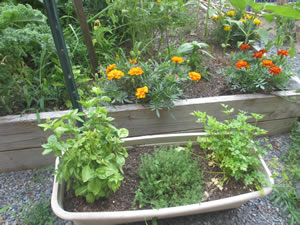Companion planting is an effective way to keep pests and disease away from your organic garden vegetables without the use of chemicals and pesticides. My husband and I have been experimenting with organic gardening techniques for the past five years, and this has become part of our successful planting strategy.
Companion planting works because certain plants emit strong odors which repel insects or improve the flavor of neighboring vegetables. Others contain disease-fighting properties that strengthen the plants that might otherwise become compromised. And still others may prefer to cohabitate simply because their tendency to grow up, out, or form a vine, compliments the growth preferences of certain other plants.
Flowers and herbs strengthen and protect many varieties of vegetables:
Nasturtium protects beans, cabbage, celery, cucumbers, melons, pumpkins and squash.
Marigolds can be a useful companion plant all around your garden, benefiting a wide variety of vegetable crops including tomatoes, squash, potatoes, pumpkins, melons, eggplant, corn, beans, and asparagus.
Beans are benefited by nasturtium, rosemary, and marigolds. All ward off several types of damaging bean beatles.
Marigolds, nasturtium and oregano all protect cucumber plants by fighting nematodes, aphids, beetles and bugs.
Best companion plant groupings:
Corn, beans and squash. Native Americans taught the early settlers to plant the “three sisters” in a circular formation. The corn stalk grows in the middle and the squash plants form a circle of low-growing bushes or vines around it. The beans vine their way up the corn stalk, and all three mature together in a mutually beneficial configuration.
According to Leslieland.com, “Corn, being tall and straight, provides support for the beans. Bean vines, being strong and wiry, build a framework around the corn that helps keep it from falling over. The big squash leaves cover the ground, conserving moisture and shading out weeds. And just to put the fudge on the sundae, the beans, being legumes, provide extra nitrogen for the corn and squash.”
Tomatoes, basil and parsley. The basil’s strong odor wards off aphids and other bugs while improving the flavor of the tomatoes. Keep in mind that the tomatoes will grow much taller than the basil, and so they (the tomatoes) should be planted “behind” the basil (behind, meaning in a more northerly direction). Otherwise, the tomatoes can easily shade out the basil entirely. Parsley is said to be similarly beneficial.
Beans do well when grown nearby beets, cabbage (and other brassica vegetables), carrots, celery, chard, corn, cucumber, eggplant, peas, potatoes or radishes.
Chamomile, garlic and the cabbage (brassica) family. These herbs will improve the flavor and growth of your cabbage, broccoli, brussel sprouts and cauliflower plants.
Chives, garlic and lettuce. Place chive and garlic plants strategically close to your lettuce plants to repel aphids which commonly feast on lettuce.
Combinations to Avoid:
Do not plant tomatoes and corn near each other. These plants are vulnerable to a certain type of worm and will attract more of this pest if grouped together.
Do not plant garlic and onions close to your pea plants, as these herbs can deter their growth.
Do not plant tomatoes and potatoes together. They can fall susceptible to the same type of blight.
Beans and peas should not be planted near onions, as it can stunt their growth.
Order our NJ Zone 6 Organic Gardening E-Guide and Encyclopedia of Veggies, Herbs and Companion Flowers
Gardening is easy… and it’s also complicated. To become a pro, why not check out our Complete Beginner’s E-Guide to Organic Gardening in NJ Zone 6. Now available in ebook format only, available for instant download via PayPal payment.


